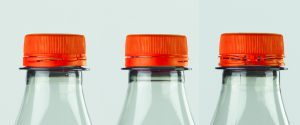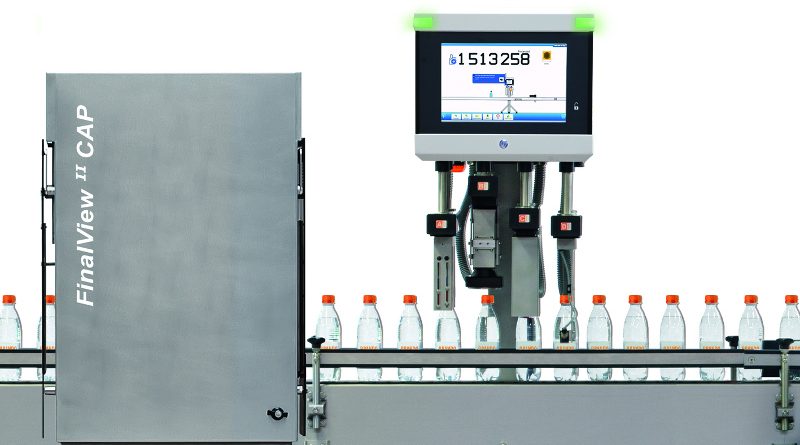Full precision during tethered cap inspection
Non-returnable PET bottles with tethered caps present great challenges for the inline quality inspection in the filling and packaging process. Heuft Systemtechnik GmbH has prepared its technology for the 360° cap inspection accordingly with intensive tests, new types of software and special lighting. With success as an installation at an important German bottler shows.
The first ones are already avail-able on the market and in the middle of 2024 they will finally become compulsory: PET bottles with tethered caps. From then on, at the latest, disposable plastic beverage containers must be equipped with new types of caps that remain firmly attached to them even after opening. This is prescribed by the EU directive 2019/904 Single Use Plastics (SUP) in order to counteract the littering of the environment by plastic waste.
However, the implementation poses major challenges for bottlers and their suppliers, which affect practically the entire production, filling and packaging process, from the stretch blow moulding machine to the filling and sealing machine to the QA equipment. Accordingly it is important for all those involved to prepare PET lines for the new closure type in good time. Heuft Systemtechnik GmbH has already made an early start with this.

Prepared for the unforeseeable
The complete quality and integrity inspection of simple symmetrical closures already succeeds reliably with the proven standard version of the Heuft FinalView II Cap even if in some cases it is not yet really foreseeable what faults and defects could occur on them in the future. It is a clear advantage that unknown objects are always displayed as faults on the high-resolution detection images which it generates. However, deviations from conventional plastic screw closures can be specifically taught in as good with the smart Heuft reflexx A.I. image processing. New features, such as initially unusually large gaps between the lid and the tamper-evidence band, are then no longer interpreted as faults but as typical for the appearance of the respective closure shape. PET full containers with corresponding features are no longer rejected; with full detection accuracy, the false rejection rate remains at the lowest level.
Optimised closure wall inspection of asymmetrical tethered caps
It is considerably more demanding to design the precise complete inspection of asymmetrical tethered closures without any gaps or “blind” areas. Heuft divides them into two main groups: Some have a completely symmetrical appearance in the top-down view but show clear asymmetrical structures in the side view due to their tether mechanism. The others even deviate from the usual rotational symmetry from both perspectives. Responsible for this is their protruding hinge. Thanks to specific software upgrades the Heuft FinalView II Cap can now inspect both subtypes in the usual precision without any compromises.
This also applies to the completely asymmetrical closures which it examines in the pilot line of a major soft drinks producer. The 26/22 tethered caps with specially developed and standardised GME 30.40 neck finishes (CETIE code) clip conveniently into a fixed position after opening, but remain connected to the container. They are not only lower and almost half a gram lighter than conventional PET bottle screw caps. Their deviating cap shape due to their protruding hinge was the reason why the closure wall inspection of the Heuft FinalView II Cap could not evaluate the images from the four cameras at first because they changed depending on the bottle orientation. And because the bottles are transported unaligned during the inspection important evaluation windows could not be set correctly for the time being. The software upgrade provided a remedy especially for completely asymmetrical tethered caps: Since then, the individual images can be rolled out to a full 360° view even in such cases, on which evaluation windows can be centered and aligned to a specific characteristic. The all-round inspection of the closure walls of asymmetrical 26/22 tethered caps thus again achieves the usual accuracy in identifying defects in this area.

Centre: The fact that deviating pixels around the tether mechanism are now tolerated does not affect the detection accuracy when inspecting the 180° opposite tamper-evidence band area, so that even the smallest defects such as broken bridges are reliably identified there.
Right: The number of pixels that deviate from the original shutter colour can vary between the left and right side of the protruding hinge. With the further developed software, this can also be taught as good and tolerable for this particular rotational position of the tethered cap.
Inspection of closure integrity
In addition, the enhanced software masters another challenge in the detection of caps that are too high and may not seal properly. This can now be done reliably from an overheight of 0.5 mm. But this is still not enough to ensure closure integrity. The proven cap angle detection of the Heuft FinalView II Cap has therefore also been further developed:
It can now be measured whether the tethered caps are always aligned at exactly the right angle to a special marking on the bottle neck – and thus it can be calculated exactly whether they have actually been screwed on as far as they should have been during the capping process. The results of the extended 360° closure wall inspection are compared with those of the standard integrated top-down camera for colour logo inspection. Together with the specifications of the closure manufacturer, it becomes directly clear in this way whether the respective full container is tightly and securely closed. Precise statistics provided by the advanced cap angle detection help the bottler to identify faulty closure heads at an early stage and to start preventive maintenance before this leads to major product losses due to leaking bottles.
Illumination for clear contour inspection
To meet yet another challenge associated with the new GME 30.40 neck finish for 26/22 tethered caps mentioned above, the compact unit for cap inspection directly on the moving conveyor has also been equipped with special lighting. Like the entire preform, it is made of recycled PET, which is less bright and transparent than conventional PET, especially in the mouth and thread area. And that makes it more difficult to detect defects around the tamper-evidence band.
But it is precisely in this sensitive area that full precision is important in order to be able to guarantee that each individual rPET bottle is securely closed and its contents remain pure and unadulterated until the end consumer opens it himself. Heuft has therefore prepared its transmitted light method for the darker material with new illumination hardware in order to track the tether mechanism and to be able to detect defective or broken tamper-evidence rings even better under such conditions.
More than “just” tethered cap inspection
The tests were successful. The same applies to the integration of the further developed Heuft FinalView II Cap into the pilot line. And the experience gained in the recently started regular operation also confirms that non-returnable PET bottles with faulty asymmetrical tethered closures are indeed reliably detected and safely rejected. For preventive maintenance, the causes of detected closure faults are localised at an early stage. After all the detection unit for the all-round closure inspection is an additional module of the Heuft Spectrum II VX which permanently monitors not only the filling valves but also the capper heads via a machine connection.
Furthermore, the modular fill management system of the new generation checks the fill level as well as the presence and position of the labels among other things. And besides the accurate rejection of faulty bottles, it realises a targeted sampling: a Heuft e-mono discharges a freely definable number of bottles onto its own lane without compressed air after the first round in the capper. All this is reliably achieved at a line speed of 40,000 bph and is designed for even higher speeds.

